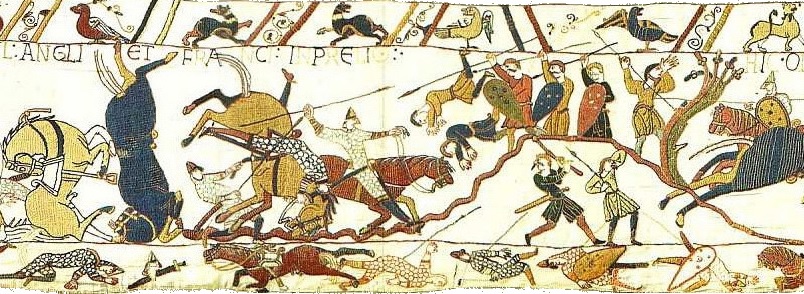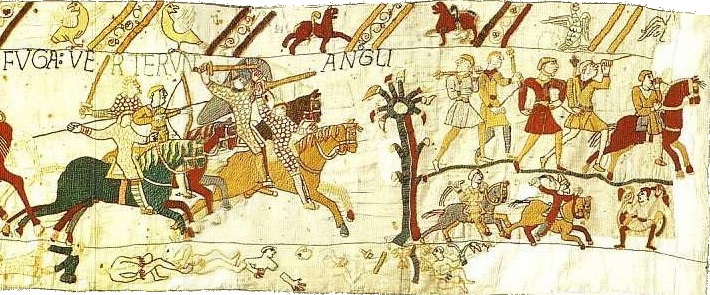
The Battle of Hastings, 1066

Introduction
William's army was ready to sail on 12 August 1066, but a strong wind kept him in port for six weeks. William did not land in England until 28 September, a few days after Godwinson had defeated Hardrada at Stamford Bridge. The Normans stole food, burned houses and killed English people.
Harold was so angry when he heard what William was doing that he ignored advice to let his men rest. He marched south in only seven days. He tired out his army.
Near Hastings, Harold stopped to let his men sleep. William left Hastings, and took Harold by surprise.
Harold took up a position near an old apple tree on top of a grassy ridge called Senlac Hill, near Hastings. He put his men into a shield wall, and flew his two flags – the Dragon of Wessex and the Fighting Man of the family Godwin. His orders were simple: 'HOLD FAST THE LINE.'
The Battle of Hastings
On the morning of 14 October 1066, William ordered his infantry (foot-soldiers) to attack. But their arrows bounced harmlessly off the English shields, and the Norman soldiers turned and ran. A rumour went round that William was dead. The Duke had to take off his helmet and ride amongst his men to stop them running away. Both sides rested and ate.
In the afternoon, William sent in his cavalry. Ivo Taillefer, a brave knight, galloped out in front, juggling his sword and lance in the air. The knights rode up the hill and crashed onto the English shield wall.
But the great war-horses could not gather enough speed up the hill. Ivo Taillefer was hacked to pieces. Many soldiers on both sides were killed, including Harold's two brothers, Gurth and Leofwinc. The Normans could not break the English line, however.
Yet just as it seemed that Harold was going to win, disaster struck. The Normans turned and pretended to run away. The English fyrd broke the line and chased after them. William's cavalry turned and cut them to pieces. The rest of the fyrd ran away.
The Death of Harold Godwinson
The housecarls refused to run away, however. They formed a ring round their king. William ordered his archers to shoot high. Harold was killed. Time after time the Norman cavalry thundered down upon their shield wall. After each attack the ring was smaller, but the housecarls did not surrender.
The Normans killed them all. Then they chased and butchered the fleeing fyrd-men until midnight.
The kingdom belonged to William.
After you have read this story and studies the Sources below, answer the question sheet by clicking on the ''Time to Work' icon at the top of the page.
Links:
The following websites will help you research further:
Accounts of the
Battle:
•
The History Learning Site - traditional account
•
Traditional
YouTube account - Dan Snow
•
TimelinesTV
- video
Site of the
Battle:
• Recently,
a Time Team special has suggested a new location for the site of the battle
Battle games
1 Hastings – a scene from the battle
All the following scenes are from the Bayeux Tapestry (made in about 1067-70).
The Latin words mean: 'English and French [are killed] in the battle':

2 Hastings – another scene from the battle
The Latin words mean: 'Here is Duke William':

3 Hastings – a third scene from the battle
The Latin words mean: 'The English turn and flee':
